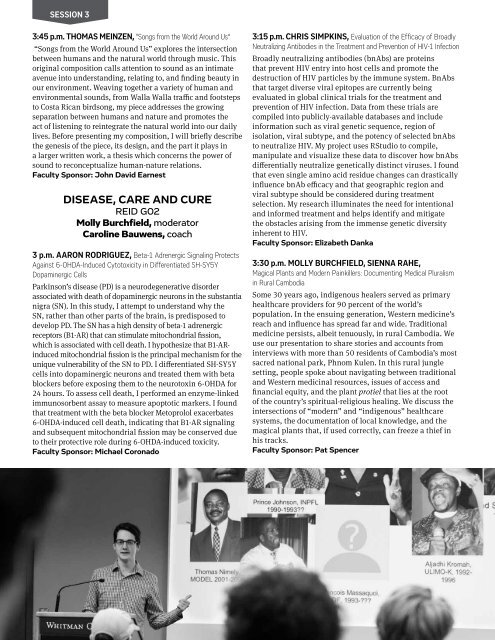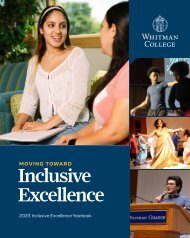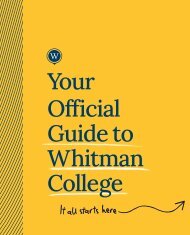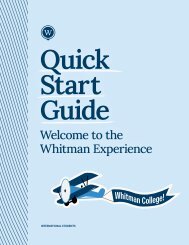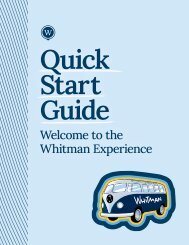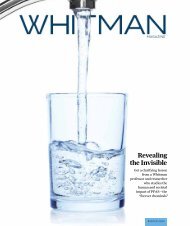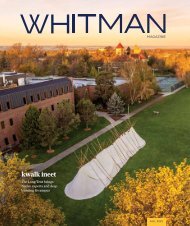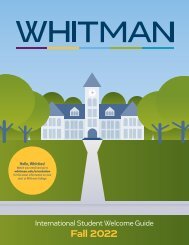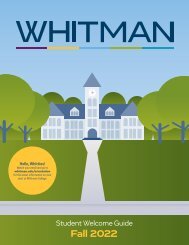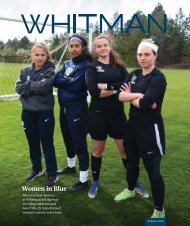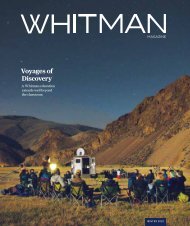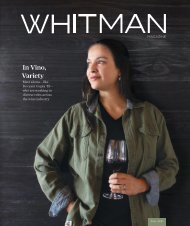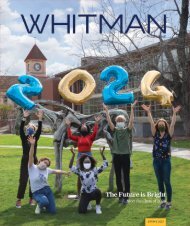Create successful ePaper yourself
Turn your PDF publications into a flip-book with our unique Google optimized e-Paper software.
SESSION 3<br />
3:45 p.m. THOMAS MEINZEN, “Songs from the World Around Us”<br />
“Songs from the World Around Us” explores the intersection<br />
between humans and the natural world through music. This<br />
original composition calls attention to sound as an intimate<br />
avenue into understanding, relating to, and finding beauty in<br />
our environment. Weaving together a variety of human and<br />
environmental sounds, from Walla Walla traffic and footsteps<br />
to Costa Rican birdsong, my piece addresses the growing<br />
separation between humans and nature and promotes the<br />
act of listening to reintegrate the natural world into our daily<br />
lives. Before presenting my composition, I will briefly describe<br />
the genesis of the piece, its design, and the part it plays in<br />
a larger written work, a thesis which concerns the power of<br />
sound to reconceptualize human-nature relations.<br />
Faculty Sponsor: John David Earnest<br />
DISEASE, CARE AND CURE<br />
REID G02<br />
Molly Burchfield, moderator<br />
Caroline Bauwens, coach<br />
3 p.m. AARON RODRIGUEZ, Beta-1 Adrenergic Signaling Protects<br />
Against 6-OHDA-Induced Cytotoxicity in Differentiated SH-SY5Y<br />
Dopaminergic Cells<br />
Parkinson’s disease (PD) is a neurodegenerative disorder<br />
associated with death of dopaminergic neurons in the substantia<br />
nigra (SN). In this study, I attempt to understand why the<br />
SN, rather than other parts of the brain, is predisposed to<br />
develop PD. The SN has a high density of beta-1 adrenergic<br />
receptors (B1-AR) that can stimulate mitochondrial fission,<br />
which is associated with cell death. I hypothesize that B1-ARinduced<br />
mitochondrial fission is the principal mechanism for the<br />
unique vulnerability of the SN to PD. I differentiated SH-SY5Y<br />
cells into dopaminergic neurons and treated them with beta<br />
blockers before exposing them to the neurotoxin 6-OHDA for<br />
24 hours. To assess cell death, I performed an enzyme-linked<br />
immunosorbent assay to measure apoptotic markers. I found<br />
that treatment with the beta blocker Metoprolol exacerbates<br />
6-OHDA-induced cell death, indicating that B1-AR signaling<br />
and subsequent mitochondrial fission may be conserved due<br />
to their protective role during 6-OHDA-induced toxicity.<br />
Faculty Sponsor: Michael Coronado<br />
3:15 p.m. CHRIS SIMPKINS, Evaluation of the Efficacy of Broadly<br />
Neutralizing Antibodies in the Treatment and Prevention of HIV-1 Infection<br />
Broadly neutralizing antibodies (bnAbs) are proteins<br />
that prevent HIV entry into host cells and promote the<br />
destruction of HIV particles by the immune system. BnAbs<br />
that target diverse viral epitopes are currently being<br />
evaluated in global clinical trials for the treatment and<br />
prevention of HIV infection. Data from these trials are<br />
compiled into publicly-available databases and include<br />
information such as viral genetic sequence, region of<br />
isolation, viral subtype, and the potency of selected bnAbs<br />
to neutralize HIV. My project uses RStudio to compile,<br />
manipulate and visualize these data to discover how bnAbs<br />
differentially neutralize genetically distinct viruses. I found<br />
that even single amino acid residue changes can drastically<br />
influence bnAb efficacy and that geographic region and<br />
viral subtype should be considered during treatment<br />
selection. My research illuminates the need for intentional<br />
and informed treatment and helps identify and mitigate<br />
the obstacles arising from the immense genetic diversity<br />
inherent to HIV.<br />
Faculty Sponsor: Elizabeth Danka<br />
3:30 p.m. MOLLY BURCHFIELD, SIENNA RAHE,<br />
Magical Plants and Modern Painkillers: Documenting Medical Pluralism<br />
in Rural Cambodia<br />
Some 30 years ago, indigenous healers served as primary<br />
healthcare providers for 90 percent of the world’s<br />
population. In the ensuing generation, Western medicine’s<br />
reach and influence has spread far and wide. Traditional<br />
medicine persists, albeit tenuously, in rural Cambodia. We<br />
use our presentation to share stories and accounts from<br />
interviews with more than 50 residents of Cambodia’s most<br />
sacred national park, Phnom Kulen. In this rural jungle<br />
setting, people spoke about navigating between traditional<br />
and Western medicinal resources, issues of access and<br />
financial equity, and the plant protiel that lies at the root<br />
of the country’s spiritual-religious healing. We discuss the<br />
intersections of “modern” and “indigenous” healthcare<br />
systems, the documentation of local knowledge, and the<br />
magical plants that, if used correctly, can freeze a thief in<br />
his tracks.<br />
Faculty Sponsor: Pat Spencer<br />
40


